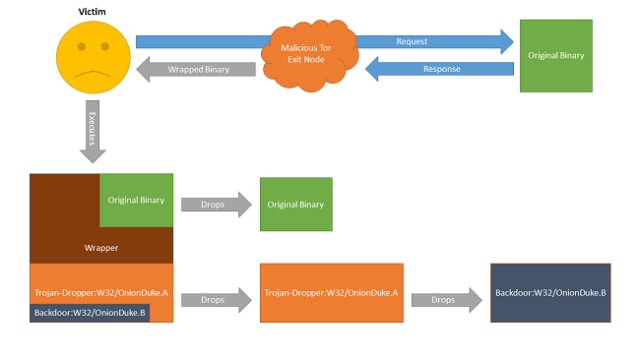
Three weeks ago, a security researcher uncovered a Tor exit node that added malware to uncompressed Windows executables passing through it. Officials with the privacy service promptly shut down the Russia-based node, but according to new research, the group behind the node had likely been infecting files for more than a year by that time, causing careless users to install a backdoor that gave attackers full control of their systems.
What's more, according to a blog post published Friday by researchers from antivirus provider F-Secure, the rogue exit node was tied to the "MiniDuke" gang, which previously infected government agencies and organizations in 23 countries with highly advanced malware that uses low-level code to stay hidden. MiniDuke was intriguing because it bore the hallmark of viruses first encountered in the mid-1990s, when shadowy groups such as 29A engineered innovative pieces of malware for fun and then documented them in an E-zine of the same name. Written in assembly language, most MiniDuke files were tiny. Their use of multiple levels of encryption and clever coding tricks made the malware hard to detect and difficult to reverse engineer. The code also contained references to Dante Alighieri's Divine Comedy and alluded to 666, the "mark of the beast" discussed in the biblical Book of Revelation."OnionDuke," as the malware spread through the latest attacks is known, is a completely different malware family, but some of the command and control (C&C) channels it uses to funnel commands and stolen data to and from infected machines were registered by the same persona that obtained MiniDuke C&Cs. The main component of the malware monitored several attacker-operated servers to await instructions to install other pieces of malware. Other components siphoned login credentials and system information from infected machines.
Besides spreading through the Tor node, the malware also spread through other, undetermined channels. The F-Secure post stated:
During our research, we have also uncovered strong evidence suggesting that OnionDuke has been used in targeted attacks against European government agencies, although we have so far been unable to identify the infection vector(s). Interestingly, this would suggest two very different targeting strategies. On one hand is the "shooting a fly with a cannon" mass-infection strategy through modified binaries and, on the other, the more surgical targeting traditionally associated with APT [advanced persistent threat] operations.
The malicious Tor node infected uncompressed executable files passing through unencrypted traffic. It worked by inserting the original executable into a "wrapper" that added a second executable. Tor users downloading executables from an HTTPS-protected server or using a virtual private network were immune to the tampering; those who were careful to install only apps that were digitally signed by the developer would likely also be safe, although that assurance is by no means guaranteed. It's not uncommon for attackers to compromise legitimate signing keys and use them to sign malicious packages.
Tor officials have long counseled people to employ a VPN use encryption when using the privacy service, and OnionDuke provides a strong cautionary tale when users fail to heed that advice.
This post was updated to remove incorrect statements concerning the use of virtual private networks.
Listing image by Tor Project
reader comments
57